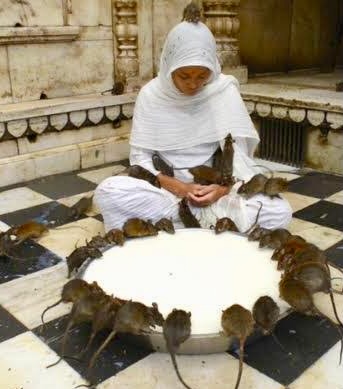Here is yet another of these extraordinary Rajasthani folklore stories, as one can hear all across India.
It is called the mahaprayan (final journey) of Karni Mata.
Karni Mata, was a mystic from the 14th century. She was considered an incarnation of the Goddess Durga. According to legend, instead of dying a normal death, she simply disappeared into a temple in Deshnoke (south of Bikaner) in 1538.
The story goes that she had informed her followers that she would disappear into the temple door (made of solid silver), and that they should not search for her physical body. On the appointed day, she walked into the temple and supposedly merged with the divine, leaving no physical remains behind. This miraculous disappearance is what’s referred to as her mahaprayan.
Since then, a small town has grown around the temple, which has become famous not only for that legend but also for estimated 25,000 rats that live there. These rats are believed to be the children of Kani Durga (I won’t retell the whole story because it is just mind boggling). As such they are reincarnations of holy individuals. It is thought that when they will be reborn, they are expected to become gifted humans. In the meantime, they scurry around the temple, attracted by the gifts of coconuts, grains and milk that pilgrims bring them.
Walking through the temple is not for the squeamish, because you can only do so barefoot. The rats inevitably run inside your feet, sometimes even across them. I couldn’t help but muse at the thought some of these might be reincarnated as investment bankers or politicians – which in the meantime just pay no attention to you. But beware: should someone accidentally step on a rat and kill it, they must replace it with one of solid gold !
All possible predators are kept at bay. Birds of prey, snakes, or just your local cat (actually you don’t see many cats in India): no predators gets in. Guards and pilgrims are on the lookout to report any danger. The monitoring for any sick or dead rat is carried out regularly.
Notwithstanding the absence of predators, the rat population has remained steady over the centuries. It seems to self-regulate itself in proportion to the size of the temple. Or maybe the amount of food made available.
This temple is visited by many pilgrims, who come from all over the state, and beyond. Such is the veneration of the animal that many worshipers, who believe the rats’ saliva has healing properties, might even share food and milk with the rats …
Some pilgrims are known to bring their new cars around, to be blessed by the rats, for good fortune.
Despite the temple being cleaned regularly, the droppings are everywhere underfoot and the smell, under the heat, is quite pungent. Wonder if the expression “smelling a rat” comes from here ?

